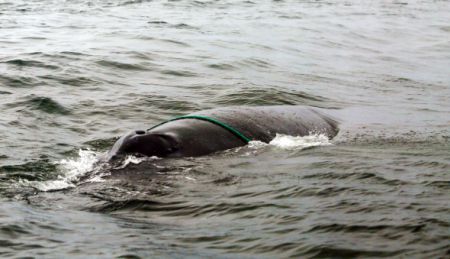A young humpback whale is missing-in-action after an unfortunate turn of events late last month.
For 36 seasons straight, the Mingan Island Cetacean Study, a non-profit organization that researches marine mammals, has launched its boats into the Gulf of St Lawrence in search of history's largest animals - the great whales. This year was no exception, and on Aug 30 they found one of these gentle giants.
A young humpback made himself visible to staff off the Gaspe Peninsula, a five-year-old still in his early days of roaming the Atlantic Ocean. They've seen this particular humpback every season since for the past five years, which makes him an old friend.
Humpback whales are the ocean's show-offs, easily recognizable for their habit of leaping clear of the water then crashing back down —an activity known as breaching. They average 15 metres in length, weigh between 34-45 tones, and when they dive, their backs form a distinctive hump, giving these acrobats their common name. The organization alone has identified more than 840 humpbacks in the Gulf since 1979.
This particular youngster, playfully named Mitts MciLroy, was a welcome sight for researchers that August day. According to staff, whales were hard to come by this season. However, this chance encounter with Mitts took an unfortunate turn for the worse the very next day.
Staff couldn't leave harbour until late afternoon that day because of strong winds, which lost them precious time.
"As soon as we left the bay, we spotted our first spout and came across the same whale not far from its location the day before," the organization reported. "As we approached however, we all noticed a green rope laying over its back. This whale was entangled."
Entanglement in fishing gear, active or abandoned, can be fatal to whales, causing them to drown or preventing them from feeding. Freeing a whale from entanglement also carries its own risks.
"This is dangerous work requiring specialized training, as entangled whales often become stressed and agitated, trying to free themselves with explosive force, tail-lobbing, breaching and moving with tremendous power," staff said.
As a member of the Quebec Marine Mammal Emergency Response Network, the organization had such training, but unfortunately their equipment was back on land. Sunset was fast approaching and the team got on the phone, hoping someone could bring them their equipment and act as spotter in case something went wrong during the untangling process, but it was too late.
No one was available.
They photographed the poor animal and took underwater footage so they could better judge the extent of the entanglement once back on land. The whale itself was reporedtly swimming alongside the boat and accepting their company in its time of need.
"It's difficult to know what a whale is thinking in such a situation and it's easy to project our own feelings and emotions onto an animal," they said. "We couldn't help thinking that, even if we couldn't free it at that moment, maybe it was at least comforting to the whale to know there was something out there with it in its moment of distress...We can only imagine how terrifying a similar situation would be for a human."
Unfortunately, this young humpback was not the first of its kind to face entanglement. According to Timothy Perrero with the Group for Research and Education on Marine Mammals, 50 cases of entanglement were reported to the Quebec Marine Mammal Emergency Response Network between 2004-2009.
Of those, 39 were confirmed to be great whales. Fourteen were humpbacks.
Staff reviewed their footage the evening of Aug 31 and discovered the whale's situation was far worse than originally thought. A three-quarter inch rope was running through the whale's mouth, caught behind its baleen-- the bristly material used by whales to filter their food from water.
The rope was anchoring the humpback to something underwater, preventing escape.
At first light the next morning, staff hit the water, this time accompanied by a conservation staff member from the Forillon National Park and a whale watching vessel on call. It was a clear day and visibility was unlimited, but in over four hours of searching, Mitts was nowhere to be seen.
"From shore we drove down the coast, stopping in small towns to scan the water with our spotting scopes, but still found nothing," staff said.
From that clear September morning until the organization concluded its work nearly three weeks later, the entangled humpback never showed himself again, leaving researchers with two possibilities: one optimistic, the other grim.
Either the struggling animal could have broken free of its restraints, escaping the area before tragedy could strike, or the poor whale could have given in to exhaustion and hunger, drowning and sinking to the bottom of the ocean.
There may be a day when researchers discover what happened to this entangled humpback, but that day is likely far off. Perhaps someone will encounter him again, snapping a photo which researchers can use to confirm his identity. Perhaps he escaped his entanglement, ready to be spotted in the next year's season, throwing his enormous body clear of the water and awing the crowd.
Until that day comes, the fate of this young humpback will remain a mystery.
Zack Metcalfe is co-organizer of the Blue Whale Campaign with the Sierra Club Atlantic chapter.
Follow him @Zack_Metcalfe



